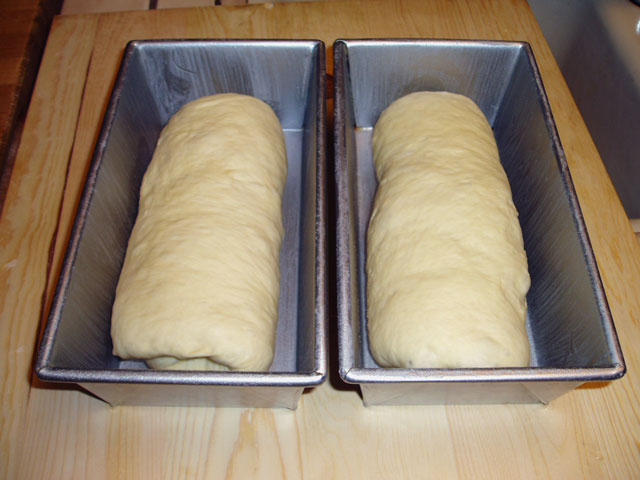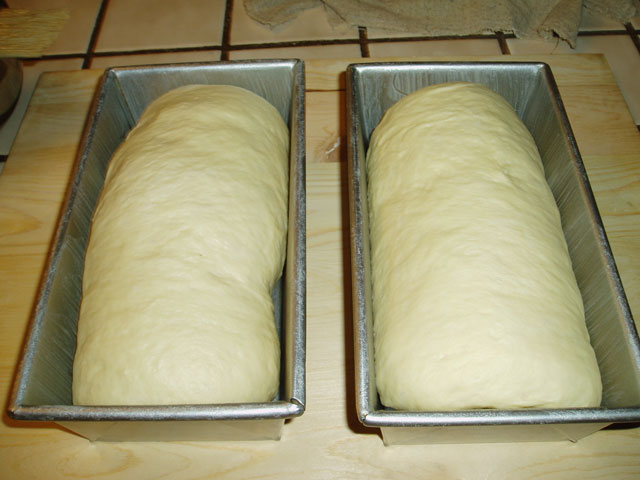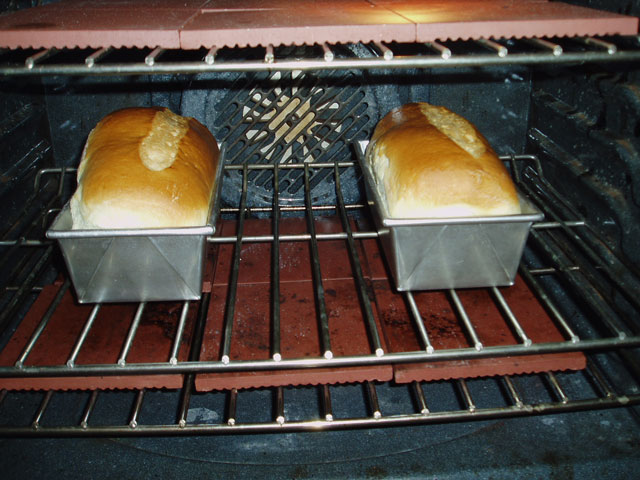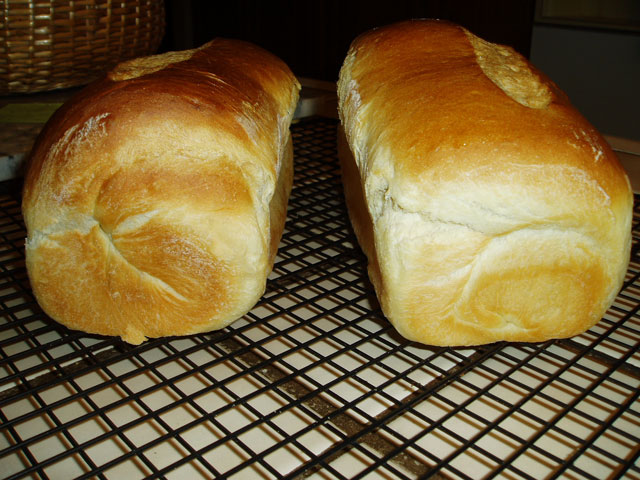Last night brought the fourth in this series of attempts to bake a proper loaf of this wonderful tasting bread. In short, this bake offered only incremental improvement over previous efforts, but the essential problem still remains unresolved. In this bake one of the two loaves promptly caved in upon removal from the baking pans for cooling. This happened within 60 to 90 seconds of removing the loaves from the pan. It happens quickly enough that you can watch the sides pull in. In this bake, however, only one of the loaves did this. That might be progress.
The changes for this bake were as follows:
1) No malt at all this time. I dropped the malt because I do not have non-diastatic malt on hand, although it is required by the formula. There is considerable discussion of the topic of malt in the posts on my prior bakes if you want to catch up there.
2) King Arthur All Purpose flour (11.7% protein) I concluded, correctly I think, that this is not a flour issue but I made the change to clear up a troubleshooting checklist item. Other bakers (see previous posts) have produced excellent loaves of this bread with other flours.
3) More careful attention to tracking dough temperature. The initial target dough temperature of 78F was achieved after combining all the ingredients in the initial mix. I was surprised at the "friction factor" input by my Bosch mixer though, and ended up with a final dough temperature going into bulk fermentation of 91F. With a 14 1/2 minute mix that's almost a degree per minute. It ended up much higher than I expected, and proves I do not use my mixer very often. If I did I'd have been more aware of this beforehand. In the end I don't think it mattered.
4) A thorough degassing of the dough by hand kneading several strokes on an unfloured board after 40 minutes of bulk fermenation that doubled the dough. The dough doubled again compared to the initial post-mix volume in another 35 minutes.
5) Aggressive degassing prior to shaping, and shaped by tightly rolling up the dough and sealing only the bottom seam, tightly.
6) I preheated my oven for 45 minutes at 375F prior to loading, and reduced to 350F immediately upon loading. I also verified my oven temperature as accurate prior to loading. My oven holds the temperature set on the control panel.
Observations:
The first and biggest point that I noticed, when rounding for the bulk rise, was that this dough seemed drier and stiffer than in previous bakes. I wished I had added more water to loosen it up, but it was, I thought, too late by then. This was even more apparent at the degassing during bulk, and I really paid for it in trying to shape the dough.
Shaping, especially trying to pre-form the dough into the requisite rectangles prior to rolling up, was made difficult by the lack of extensibility in this dough. It was very like working with a big, heavy rubber band. I could stretch it out, with difficulty, but it would pull back immediately if I let go. It was very difficult to pre-shape, even after a 30 minute rest after dividing. (Is this a result of holding out the malt, even the wrong type?) Due to the dryness of the dough it was also difficult to seal the seams. After finally getting the bottom seams to seal I elected to just leave the ends open. I really missed the silky suppleness of this dough in previous bakes.
Final proofing took longer, as I expected, due I'm certain to the degassing and second bulk rise. Instead of taking 45-60 minutes, these were not ready to bake until 75-80 minutes after shaping. I proofed these on a bookshelf waist high and a few feet from the wood stove. The thermometer on that shelf read 75F for the entire time period (good wood stove!). This is the same place I proofed attempt #3 the previous evening.
Here is the pictorial record:

Shaped, panned and ready for final proof.

Proofed and ready for the egg wash and slash.

This shows the relative positions in the oven, and the uneven spring/shape and orientation.

Finished loaves.

The cross-section shows some much larger holes in the crumb than were present in previous bakes. It also makes clear that the sides of this loaf caved in, one more than the other, once again. This cave in only happened on one of the two loaves though. This shot does not show it, but this loaf also had some side-wall compression expressed in a doughy strip just inside the crust, but not as much as previous bakes. The other loaf looks quite nice, and I will gift it to a neighbor. We have plenty, trust me.
So, some forward progress is made, but not a lot. The dough did not seem dry during the mix as I checked the gluten development, but it certainly was apparent when I tried to round the dough for bulk fermentation. I am unsure about why this dough was so elastic. I think that if I can resolve those issues I can do a better job of shaping and so better control the spring of the loaf. The degassing and second rise in bulk fermentation seems to have controlled the oven spring. I think this bake produced far more normal spring in the oven than any of my previous attempts. Thanks go to MiniOven and Andy for that!
I will bake this yet again, but not until next week. I have other commitments for the next few evenings, and I need a break too. Perhaps just some time to reflect and back up out of the leaves will give me a more productive view of the forest on this one. I think I will bake some sourdough this weekend, just to do something different as well.
Thanks for stopping by!
OldWoodenSpoon
- OldWoodenSpoon's Blog
- Log in or register to post comments
I really admire your stamina in these repeated bakes! I have only one observation and it may be nothing at all; but your panning of the loaves leaves gaps between the bread and the pan wall. The cave in the the baked loaf seems to correspond to the gap in one of the prebaked loaves. My experience in panning is to gently pat the shaped dough to fill the pan all around.
Your trials will really help when my turn comes around, as this is definately the first bread I will attempt when my ITJB arrives on the 15th!
Phyllis
it is stamina or stubbornness, but thank you Phyllis. You will love this book, and despite my own difficulties with it I know you will love this bread!
I was not careful to maintain left loaf/right loaf consistency as I worked through this bake, so you may be misled by assuming that I did. I think the proofed loaf that shows that gap was actually the loaf that did not cave in, and that I did not slice into. I do understand your point though. I should look back over my pictures of these successive bakes to see if I have any other evidence to corroborate the theory. As for these loaves: they were so difficult to shape that I don't think I could have "patted" them with anything short of a mallet to fit them into the pans!
OldWoodenSpoon
Kudos on your persistence. It does look like your results are improving. Are you depanning the loaves immediately after removing them from the oven?
Yes, what few changes in the outcome there have been have, at least, been positive. In answer to your question, yes, I take the loaves out of the pans within a minute or two of taking them out of the oven.
OldWoodenSpoon
I note that the sides only cave in some time after removing from the oven and the pans. Have you tried something very simple such as tipping the loaves out of the pans for the final 10 mins of cooking time to let the sides dry and crisp?
I apologise if this has already been suggested/tried. Patsy
Thank you Patsy. I appreciate you taking time to think about this. While it was suggested some time ago in one of my earlier attempts I have not yet tried it, and I appreciate the reminder.
I have not yet tried it because I am doing my best to stay as close as possible to the original formula and method. Norm baked this bread in a production bakery by the 100's of loaves. There is no way he could have tipped every loaf out before it was done, so I am doing something wrong (more likely many small things) or using improper equipment, ingredient(s) or something. I'm determined to figure out what that/those factors are. Some might call it stubborn, but I prefer to think of it as a deep sense of respect for those bakers that this book reveals to us, beginning but certainly not ending with Norm Berg and Stan Ginsberg.
I really do appreciate the thought Patsy.
OldWoodenSpoon
In that case my money is on Eric's suggestion; if the oven spring and top browning are reduced, a slightly longer bake might set the sides and prevent the cave ins. Patsy
OWS, please try removing the top tiles from your oven. I'll bet this is what is causing your breads to perform in such a way. The additional radiation heat speeds up the spring.
Eric
I wonder if it might be even better yet to remove all the tiles, and bake on a single rack in the center of the oven? I think I would continue the extra degassing and second rise in bulk fermentation, at least initially, but if you are right those might not be needed either.
Thanks Eric!
OldWoodenSpoon
After responding to Patsy earlier about how I must be doing something (very?) different from the original formula, another thought occured to me: my bread pans. My apology to MiniOven a day or two ago for not paying more attention to her primary subject. I glossed over her "Shiny pans?" mention and moved on to something else I took more notice of (malt!). However, after reading more on the shiny vs dark pan performance differences, and thinking more about what I might be doing that is different, I finally realized: Norm or Stan would not have been baking this bread in a shiny Chicago Metallic bread pan. I looked back at Eric Hanner's pictures in his blog post on this bread, and he also is using dark pans. I need to get a couple of dark bread pans for my next test bake.
So, thinking "out loud" about my strategy for the next bake (whenever that comes to pass), here is what I am currently considering:
1) Continuing with the KAF All Purpose flour without the addition of any extra malt, (contrary to the prescribed formula)
2) Making a small extra addition of water to the dough at mixing, to overcome the apparent excessive dryness encountered in the 4th test bake. If this accomplishes my intention, I'll be able to more carefully shape the loaves as well.
3) Continuing the extra rise in bulk fermentation, with a thorough degassing after the first doubling of the dough
4) Remove all the tiles from the oven and bake on a single wire rack in the center with normal heat (not convection), pre-heated high (375F) before loading, then immediately backed down to the specified 350F for the bake. If this results in exceptionally low or even just low normal oven spring in this test I'll know I may no longer need the knock-down and extra rise in bulk fermentation.
5) Bake in my not-shiny new dark bread pans
There are a number of other things I could test as well, but this is probably already too many changes to build into just one test.
I still have an open question in my mind about the reason for the elasticity problems I encountered in test bake 4 above. Was this just a low-hydration side effect? Was it due to holding back the malt? Was the former dough condition an improper effect of having used low-diastatic malt instead of non-diastatic malt? I don't know, but I could use some advice on this before the next test bake because it bears on strategy element #2 above.
Does all this make sense?
Still baking happy, with a big grin on my face. :)
OldWoodenSpoon
you are baking this hot enough? I have made the BBA version repeatedly, free-form and with good success. It is baked at 450 F?
that 350F is the correct temperature. It is the temperature printed in the book. It is further validated by Eric Hanner's test bake a couple of days ago. He documented that bake in his blog, which is also linked to from my earlier blog posts. I am as sure as I can be then. Also, I know the bread is getting done because it tastes wonderful, makes great French Toast, regular toast with butter and jam, sandwiches... You can trust me on that much because we've been eating a lot of it around here this week. :) It just collapses as soon as it starts to cool.
With all that said though, you are not alone in thinking that 350F is too cool for this bread. If you read my earlier blog entries you will see a post by Andy (ananda) that makes the same point. He convinced me to at least pre-heat to a higher temperature, and then fall back to the lower temperature after loading. He actually wanted me to bake it hotter too. I am trying the approach in concept, but I fall back to the temperature called for in the original recipe.
Thanks for your interest, and thank you too for challenging me in what I am doing here. It forces me to analyze it for myself. Often that leads to enlightenment.
OldWoodenSpoon
and your bread looks done. I'm still surprised (now I'll have to try that version, too...). Does it collapse, too, if you leave it in the pan for a little? The bread's structure must be so delicate that it can't hold its own outside of the pan if still hot. That would happen, say, with a German-style pound cake (Sandkuchen). You have to let that sit IN the pan for a little before you let it cool completely on a cooling rack.
I suggest you make only the one change, removing the TOP tiles, and bake again. Otherwise you will never know what solved your issue. The dark pans do absorb heat more efficiently. I'm pretty sure just removing the top tiles will solve this.
Eric
and bake at the same time with the other loaf in the shiny pan. Then you can compare side to side. If the tiles are removed and the shiny pan acts the same, then it's not the tiles. That would be one way of changing two variables at the same time.
I do have a twin set of shiny pans (those from Costa Rica) my mil has them and uses them for a much sweeter dough as she doesn't want them to brown. She then cuts up her low temp bread (also 350°F or 175°C) and browns it a second time in the oven to dry it out, sort of like melba toast. Your dough is not so sweet, my instinct tells me the loaves are not brown enough on the bottom & sides. I am tempted to cover the lovely golden tops with foil and bake longer or slip them out of the pans to brown a little more, maybe even upside down! I have to agree with Eric that there may be too much heat radiating from above. You may have to add 5 to 8 minutes to the baking time without the upper tiles but I think he has a good point. That might just be the time the loaves need to brown the sides so they don't suck in. :)